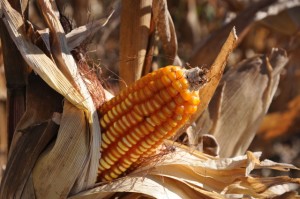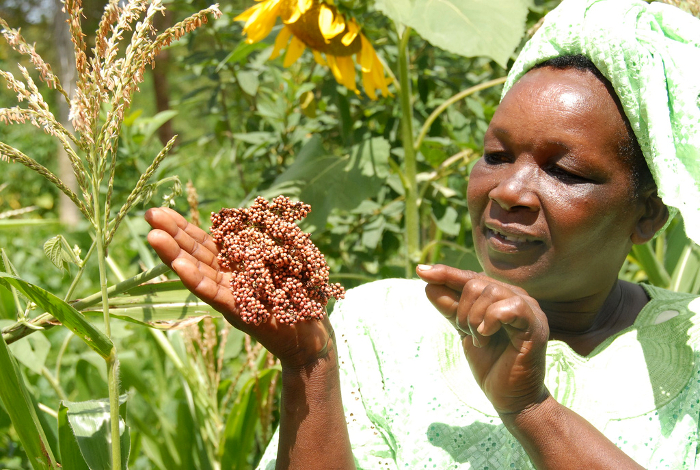A little over a decade ago, a PhD student in Brazil was poring over sorghum genes, trying to isolate one that helps plants withstand acidic soils.
Scientists at the Brazilian Corporation of Agricultural Research (EMBRAPA) had been researching plants that can grow well in acidic soils since the mid-1970s.
“What we have done within the Generation Challenge Programme,” explains Jurandir Magalhães, now a senior scientist for EMBRAPA, as he reflects back on the past decade, “is speed up maize and sorghum breeding for acidic soil adaptation”.
EMBRAPA partnered with the CGIAR Generation Challenge Programme (GCP) to advance plant genetics so as to breed aluminium-tolerant crops that will improve yields in harsh environments, in turn improving the quality of life for farmers.
Almost 70 percent of Brazil’s arable land is made up of acidic soils. That means the soil has toxic levels of aluminium and low levels of phosphorous – a lethal combination that makes crop production unsustainable. Aluminium toxicity in soil comes close to rivalling drought as a food-security threat in critical tropical food-producing regions. This is because acidic soils reduce root growth and deprive plants of the nutrients and water they need to grow.
Robert Schaffert – EMBRAPA’s longest-serving sorghum breeder – had developed mapping populations for aluminium tolerance in sorghum; these populations were the basis for the work supported by GCP.
During the first four years of the 10-year Programme, Jurandir was able to identify and clone the major aluminium-tolerance gene in sorghum – AltSB – using these mapping populations. The cloned gene has since enabled researchers across Africa and Asia to quickly and efficiently breed improved sorghum and maize plants that can withstand acidic soils.
Jurandir, speaking today about the work to advance sorghum genetic resources, says: “Wherever there are acidic soils with aluminium toxicity and low phosphorous availability, our results should be applicable.”
His story with EMBRAPA is one of many where GCP-supported projects have been instrumental in helping global research centres achieve their goals, which ultimately will help farmers worldwide.
Common objectives
Jurandir is now a research scientist in molecular genetics and genomics at the EMBRAPA Maize & Sorghum research centre. He and colleagues at the centre partnered with scientists in Africa, Asia and the US to identify and clone genes in sorghum, maize and rice that confer resistance or tolerance to stresses such as soil acidity, phosphorus efficiency, drought, pests and diseases.
“One important focus of GCP was linking basic research to applied crop breeding,” Jurandir says. “This is also the general orientation of our programme at EMBRAPA. We develop projects and research to produce, adapt and diffuse knowledge and technologies in maize and sorghum production by the efficient and rational use of natural resources.
“GCP provided both financial support and a rich scientific community that were useful to help us attain our common objectives.”
EMBRAPA’s work on cloning the AltSB gene would prove to be one of the first steps in GCP’s foundation sorghum and maize projects, both of which sought to provide farmers in the developing world with crops that will not only survive but thrive in the acidic soils where aluminium toxicity reduces crop production.
Leon Kochian of Cornell University in the US was Jurandir’s supervisor at the time when they applied for GCP funding. Leon was a Principal Investigator for various GCP research projects, researching how to improve grain yields of crops grown in acidic soils.
“The breeders are so important,” says Leon about the importance of supporting institutes such as EMBRAPA to advance plant genetics. “Ultimately, they are the cliché of ‘the rubber hits the road’. They’re the ones who translate what we’re trying to figure out into the actual crop improvements. That’s really what it’s all about.”
“That’s why EMBRAPA is a unique institution. Their mission is to get improved seed out, new germplasm out, for the farmers. They have the researchers in sorghum and maize breeding [Robert Schaffert and Sidney Parentoni] and molecular biology [Jurandir Magalhães and Claudia Guimarães].”
Great minds think alike
Jurandir’s EMBRAPA colleague Claudia Guimarães, a plant molecular geneticist focusing on maize, says GCP promoted ‘products’, which also echoed the mission statement of EMBRAPA’s Maize & Sorghum research centre.
The centre’s mission is to: ‘Generate, adapt and transfer knowledge and technology that allows for the efficient production and use of maize, sorghum, and natural resources as well as promotes competitiveness in the agriculture sector, sustainable development, and the well-being of society.’
GCP, says Claudia, “wanted to extract something else from the science – products – the idea of a real, touchable product. You have to have progress: germplasm, lines, markers; they are quite practical things.
“The major goal of GCP is to deliver products that can improve people’s lives worldwide. So it needs to be readily available and useful for other scientists and for the whole community.”
GCP wanted to ensure that research products could and would be adopted, adapted and applied for the ultimate benefit of resource-poor farmers. The Programme therefore set out to catalyse interactions between the various players who are needed to bridge the gap between strategic research in advanced labs and resource-poor farmers.
GCP and EMBRAPA were both working towards tangible applied outcomes, says Claudia: “GCP was not only giving you money, they are really serious about what are you doing: ‘Did you deliver everything you promised?’”
Claudia delivered. She and her team at EMBRAPA were able to find an important aluminium-tolerance gene in maize similar to the sorghum gene. This outcome provided the basic materials for molecular-breeding programmes focusing on improving maize production and stability on acidic soils in Africa and other developing regions.

Maize trials in the field at EMBRAPA. The maize plants on the left are aluminium-tolerant while those on the right are not.
Multifaceted and tangible results
Through further GCP funding, EMBRAPA researchers Robert Schaffert and Sidney Parentoni were able to work together with two researchers from Kenya, Dickson Ligeyo and Samuel Gudu, to develop a breeding programme to combine the improved Brazilian germplasm with locally adapted Kenyan materials. A new base of improved germplasm was established for Kenyan breeders, which allowed the development of varieties adapted to acidic soils in Kenya.
Sidney, a maize breeder for GCP projects and now the deputy head of research and development for EMBRAPA Maize & Sorghum, says that the benefits of being part of GCP are multifaceted: “It was very important, not only for EMBRAPA as an institute, but also individually for each of the participants that had the opportunity to interact with partners in different parts of the word,” says Sidney.
“Each of them adds a piece to build the results achieved by GCP, which from my perspective promoted a number of advances in the areas of genetics and breeding.
“Technologies such as root image scanning developed at Cornell [University] were transferred to EMBRAPA and allowed us to do large-scale screening in a number of maize and sorghum genotypes with large impacts in phosphorous-efficiency studies.
“Scientists from Africa were trained in breeding and screening techniques at EMBRAPA, and Brazilian scientists had the opportunity to go to Africa and interact with African researchers to jointly develop strategies for breeding maize and sorghum for low-phosphorous and acidic soils.
“These trainings and exchanges of experiences were very important for the people and for the institutions involved,” says Sidney.
Sustainable partnerships to break ground for groundnut
Soraya Leal-Bertioli is a researcher in the EMBRAPA Genetic Resources & Biotechnology centre. She works on groundnut (also known as peanut), and formed part of the GCP team working on groundnut with tolerance to drought and resistance to diseases and fungal contamination. She concurs that GCP united researchers from all over the globe in a common goal.
“GCP not only identified groups, but it went out, searched for people and invited contributions, offered resources to get them together. GCP brought partnerships to a whole new level,” Soraya says.
“Last time I checked there were 200 partners in 50 countries. No one is able to do that. It required a lot of money, a lot of resources, but the way it was dealt with in GCP was: ‘Let’s reach out for the main players, the ones who have the technology, and also the ones who can use the technology’.
“GCP used the resources for the benefit of the community and brought everybody together.”
Soraya says the traditional way of funding research often had ‘no structure’.
“Sometimes a university or funding body receives a large amount of money and decides to build something, a new institute in the middle of the jungle somewhere, but they don’t have anybody to run it; it is not sustainable.
“What GCP did was help to provide the structure and the agents for the whole system. They helped train the people to run the whole system. This is a very sustainable model, which is very likely to give good results in a much shorter time frame than other programmes.”
Watch Soraya – and other members of the team – discuss the complex personality of groundnut and groundnut research in our video series:
Genetic stocks AND people are products
The products and outcomes of the collaboration with GCP have included both the tangible and the not-so-tangible. Sidney says that a large quantity of Brazilian improved maize and sorghum lines tolerant to acidic soils has been developed over the years at EMBRAPA.
“These materials were shared with partners in Africa, and this was a major contribution to Kenyan farmers, as part of this collaborative work done in the scope of GCP.
“To be part of the programme has been very important for EMBRAPA’s research team. It has given us the opportunity to interact with a diversity of institutes.”
Sidney mentions institutes they gave worked with through GCP, including Cornell University and Texas A&M University in the US, the Japan International Research Center for Agricultural Sciences (JIRCAS), the International Rice Research Institute (IRRI), the International Maize and Wheat Improvement Center (CIMMYT), and various institutes in Africa, such as Moi University, Kenya, and the Kenya Agricultural and Livestock Research Organisation (KALRO).
Sidney concludes: “In this large network of partnerships, EMBRAPA was able to learn and to share information in a highly productive way.
“From my perspective, the involvement with GCP projects allowed me to grow as a researcher and as a person, and also at the same time to share and to acquire new knowledge in a number of areas. I think it was a ‘win-win’ interaction for all the participants.”
Many of the products generated within the scope of GCP, such as markers and germplasm, are already available within EMBRAPA’s breeding programmes. Avenues for further research have been paved based on the GCP achievements, and these new research lines will be continued within new projects.
As Claudia says: “The strong partnerships built along the way with GCP will be maintained by us joining with new research teams from other institutes and countries to work on new projects.”
More links
- Here on the Sunset Blog: All in the family: sister genes help breed better crops
- Comparative Genomics Blogposts | Research Initiative | InfoCentre
- Partner profiles: Claudia | Jurandir












